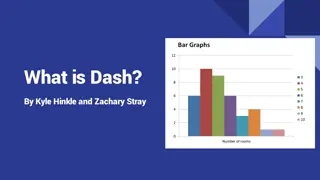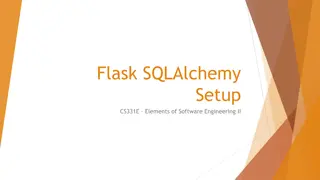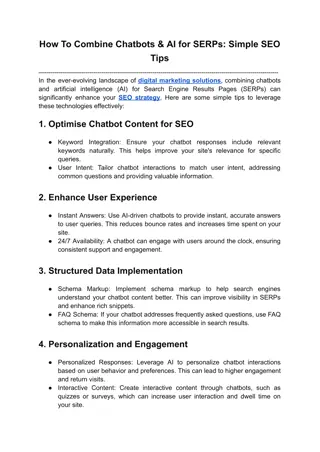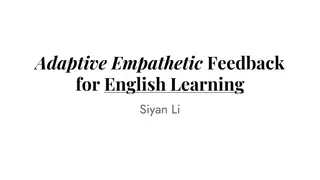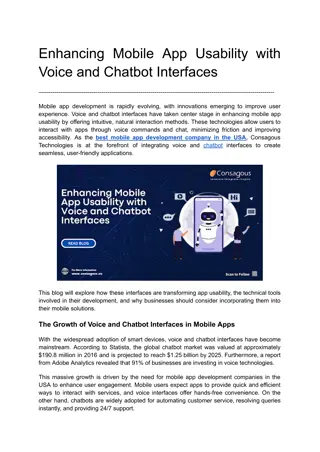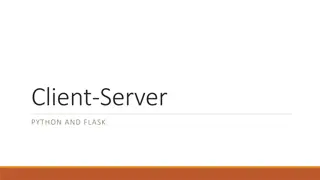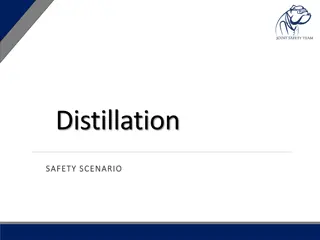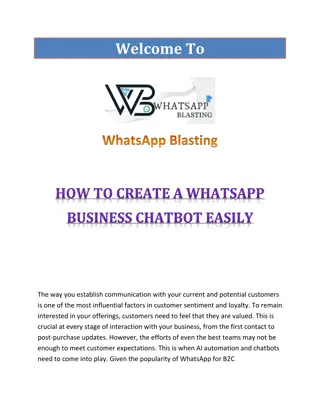Implementing Chatbot Functionality with Flask
"Develop a chatbot application with Flask framework for seamless interaction. Includes features for user input, FAQ display, quizzes, and end functionality. Enhance user experience in a structured layout with easy navigation."
Download Presentation

Please find below an Image/Link to download the presentation.
The content on the website is provided AS IS for your information and personal use only. It may not be sold, licensed, or shared on other websites without obtaining consent from the author.If you encounter any issues during the download, it is possible that the publisher has removed the file from their server.
You are allowed to download the files provided on this website for personal or commercial use, subject to the condition that they are used lawfully. All files are the property of their respective owners.
The content on the website is provided AS IS for your information and personal use only. It may not be sold, licensed, or shared on other websites without obtaining consent from the author.
E N D
Presentation Transcript
Flask Teoh Teik Toe ITOM/NBS ttteoh@ntu.edu.sg 97905202
from flask import Flask,request,render_template app = Flask(__name__) Index chatbot <style> .container{width: 100%; margin:auto} @media (min-width:600px){.container{width: 80%;}} @media (min-width:768px){.container{width: 60%;}} @media (min-width:1024px){.container{width:50%;}} </style> first_time = 1 name = "" @app.route("/",methods=["GET","POST"]) def index(): return(render_template("index.html")) @app.route("/main",methods=["GET","POST"]) def main(): global first_time, name if first_time == 1: name = request.form.get("name") first_time = 0 return(render_template("main.html",r=name)) <div class="container"> <h1>Welcome to chatbot</h1> <form action="/main" method="post"> <h2>Please enter your name</h2> <input type="text" name="name"> <input type="submit" value="Enter"> </form> </div> FAQ1 <style> .container{width: 100%; margin:auto} @media (min-width:600px){.container{width: 80%;}} @media (min-width:768px){.container{width: 60%;}} @media (min-width:1024px){.container{width:50%;}} </style> @app.route("/faq1",methods=["GET","POST"]) def faq1(): return(render_template("faq1.html")) <div class="container"> <h1>FAQ1</h1> <form action="/main" method="post"> <input type="submit" value="Main"> </form> </div> Main <style> .container{width: 100%; margin:auto} @media (min-width:600px){.container{width: 80%;}} @media (min-width:768px){.container{width: 60%;}} @media (min-width:1024px){.container{width:50%;}} </style> @app.route("/quiz",methods=["GET","POST"]) def quiz(): return(render_template("quiz.html")) @app.route("/quiz_answer",methods=["GET","POST"]) def quiz_answer(): a = request.form["option"] if a=="yes": return(render_template("quiz_correct.html")) else: return(render_template("quiz_wrong.html")) <div class="container"> <h1>Hi, {{r}}. Main Menu</h1> <form action="/faq1" method="post"> <input type="submit" value="FAQ1"> </form> <form action="/quiz" method="post"> <input type="submit" value="Quiz"> </form> <form action="/end" method="post"> <input type="submit" value="End"> </form> </div> @app.route("/end",methods=["GET","POST"]) def end(): return(render_template("end.html")) if __name__ == "__main__": app.run()
Quiz Quiz Correct Quiz Wrong <style> .container{width: 100%; margin:auto} @media (min-width:600px){.container{width: 80%;}} @media (min-width:768px){.container{width: 60%;}} @media (min-width:1024px){.container{width:50%;}} </style> <style> .container{width: 100%; margin:auto} @media (min-width:600px){.container{width: 80%;}} @media (min-width:768px){.container{width: 60%;}} @media (min-width:1024px){.container{width:50%;}} </style> <style> .container{width: 100%; margin:auto} @media (min-width:600px){.container{width: 80%;}} @media (min-width:768px){.container{width: 60%;}} @media (min-width:1024px){.container{width:50%;}} </style> <div class="container"> <h1>Quiz: Answer is yes</h1> <form action="/quiz_answer" method="post"> <input type="radio" name="option" value="yes">yes</input> <input type="radio" name="option" value="no">no</input> <input type="submit" value="Enter"> </form> </div> <div class="container"> <h1>Your answer is correct</h1> <form action="/main" method="post"> <input type="submit" value="main"> </form> </div> <div class="container"> <h1>You answer is wrong</h1> <form action="/main" method="post"> <input type="submit" value="Main"> </form> </div> End <style> .container{width: 100%; margin:auto} @media (min-width:600px){.container{width: 80%;}} @media (min-width:768px){.container{width: 60%;}} @media (min-width:1024px){.container{width:50%;}} </style> <div class="container"> <h1>Thank you, good bye!!</h1> </div>
Text Sentiment - 3 pages submit buttons Index.html <html> <h1>My second ML cloud based model: Text Sentiment</h1> <form action="/result" method="post"> <p>Please enter the text</p> <p><input type="text" name="t"></p> <p><input type="submit" value="Enter"></p> </form> </html> from flask import Flask,request,render_template from textblob import TextBlob app = Flask(__name__) @app.route("/",methods=["GET","POST"]) def index(): return(render_template("index.html")) @app.route("/result",methods=["GET","POST"]) def result(): t = request.form.get("t") result = TextBlob(t).sentiment return(render_template("result.html",result=result)) result.html <html> <p><h2>6 The sentiment of the text {{result}}</h2></p> <form action="/next" method="post"> <p><input type=submit value=Next></p> </form> <form action="/end" method="post"> <p><input type=submit value=End></p> </form> </html> @app.route("/next", methods=["GET","POST"]) def next(): return(render_template("index.html")) @app.route("/end", methods=["GET","POST"]) def end(): return(render_template("end.html")) if __name__ == "__main__": app.run() End.html <html> <h1>Thank you</h1> </html>
Flask with responsive <style> .container{width: 100%; margin:auto} @media (min-width:600px){.container{width: 80%;}} @media (min-width:768px){.container{width: 60%;}} @media (min-width:1024px){.container{width:50%;}} </style> <div class="container"> <h1>Thank you</h1> </div>
Size button and picture <img src=" width="300" height="200"> <form action="/result" method="post"> <p>Please enter the text</p> <p><input type="text" name="t"></p> <p><input type="submit" value="Enter" style="width:100px;height:100px;"></p> </form>
Flask Radio Button back end from flask import Flask,request,render_template app = Flask(__name__) @app.route("/",methods=["GET","POST"]) def index(): if request.method == "POST": a = request.form['options'] print(a) return(render_template("index.html")) if __name__ == "__main__": app.run()
Radio button <html> <h1>radio button 5</h1> <form action="/" method="post" > <p> <input type="radio" name="options" id="option1" value="option1"> Option1 </input><br> <input type="radio" name="options" id="option2" value="option2"> Option2 </input><br> <input type="radio" name="options" id="option3" value="option3"> Option3 </input><br> </p> <p><input type=submit value="Next"></p> </form> </html>
Flask Back End for Web Development Competitor is Node (js)
Flask Basic # create 2 directories static and template from flask import Flask app = Flask(__name__) @app.route("/") def index(): return "Hello world!" app.run()
Add one Link (Add <h1> <h1> to increase font size @app.route("/Welcome") def wel(): return <h1>Welcome to Flask!<h1>" Basic html https://www.w3schools.com/html/html_intro.asp
Using html templates Open VS code (open new file) # create a html file in folder templates from flask import render_template @app.route("/html") def h1(): return render_template("h.html")
CSS same as html file @app.route("/css") def css(): return render_template("css.html")
Flask run js file @app.route("/js") def js(): return render_template("HTML_JS_Flask.html") <h1>This is the html that call JS</h1> <script src = "{{url_for('static', filename = 'js1.js')}}"></script> document.write("Welcome to Js");
Running JS in html <!DOCTYPE html> <html> <body> <h1>My First JavaScript</h1> <p>JavaScript can change the content of an HTML element:</p> <button type="button" onclick="myFunction()">Click Me!</button> <p id="demo">This is a demonstration.</p> <script> function myFunction() { document.getElementById("demo").innerHTML = "Hello JavaScript!"; } </script> </body> </html>
Build & Load Model import pandas as pd df = pd.read_csv("DBS_SingDollar.csv") X = df.loc[:, ["SGD"]] Y = df.loc[:, ["DBS"]] from sklearn import linear_model model = linear_model.LinearRegression().fit(X,Y) pred = model.predict(X) from sklearn.metrics import mean_squared_error print(mean_squared_error(Y, pred)**0.5) import joblib joblib.dump(model, "DBS Regression Model")
Flask from flask import Flask app = Flask(__name__) from flask import request, render_template import joblib @app.route("/", methods = ["GET", "POST"]) def i(): if request.method == "POST": name = request.form.get("name") print(name) num = request.form.get("rates") print(num) model = joblib.load("DBS Regression Model") pred = model.predict([[num]]) print(pred) s = "Predicted DBS Share Price : " + str(pred) print(s) return(render_template( main.html", result = s)) else: return render_template( main.html", result ="DBS Share Price Prediction") #if run on command line if __name__=="__main__": app.run(debug=True) app.run()
HTML Basic Syntax The <!DOCTYPE html> declaration defines that this document is an HTML5 document The <html> element is the root element of an HTML page The <head> element contains meta information about the HTML page The <title> element specifies a title for the HTML page (which is shown in the browser's title bar or in the page's tab) The <body> element defines the document's body, and is a container for all the visible contents, such as headings, paragraphs, images, hyperlinks, tables, lists, etc. The <h1> element defines a large heading The <p> element defines a paragraph <!DOCTYPE html> <html> <head> <title>Page Title</title> </head> <body> <h1>My First Heading</h1> <p>My first paragraph.</p> https://www.w3schools.com/html/html_intro.asp </body> </html>
HTML What is an HTML Element? An HTML element is defined by a start tag, some content, and an end tag: <tagname>Content goes here...</tagname> The HTML element is everything from the start tag to the end tag: <h1>My First Heading</h1> <p>My first paragraph.</p>
<form>: The Form element The <form> HTML element represents a document section containing interactive controls for submitting information. Html - form POST vs. GET Methods We can use either the post or get method with a form. Use the get method to request, or get, data from a resource. Use the post method to submit data to be processed by a resource. Read more: https://html.com/forms/tutorial/#ixzz7JmmNbrz4 <html> <body> <form action = "http://localhost:5000/" method = "post"> <p>Enter Name:</p> <p><input type = "text" name = "name" /></p> <p>Enter exchange rate:</p> <p><input type = number" step = 0.01 name = "rates" /></p> <p><input type = "submit" value = "submit" /></p> </form> {{result}} </body> </html> https://developer.mozilla.org/en-US/docs/Web/HTML/Element/form
<input type="button"> <input type="checkbox"> <input type="color"> <input type="date"> <input type="datetime-local"> <input type="email"> <input type="file"> <input type="hidden"> <input type="image"> <input type="month"> <input type="number"> <input type="password"> <input type="radio"> <input type="range"> <input type="reset"> <input type="search"> <input type="submit"> <input type="tel"> <input type="text"> <input type="time"> <input type="url"> <input type="week"> Input type https://www.w3schools.com/html/html_form_input_types.asp
HTML style (Jinja) is frontend, we use Flask for backend
Flask from flask import Flask, render_template, request app = Flask(__name__) @app.route('/') def main(): return render_template('query.html') @app.route('/process', methods=['POST']) def process(): # Retrieve the HTTP POST request parameter value from 'request.form' dictionary _username = request.form.get('username') # get(attr) returns None if attr is not present return render_template('response.html', username=_username) app.run()
HTML as front end, save in templates (query and response) <html> <head> <title>Entry Page</title> </head> <body> <form action="process" method="post"> <label for="username">Please enter your name: </label> <input type="text" id="username" name="username"><br> <input type="submit" value="SEND"> </form> </body> </html> <html> <head> <title>Response Page</title> </head> <body> <h1>Hello, {{ username }}</h1> </body> </html>
What is Jinja Jinja is a web template engine for the Python programming language.





